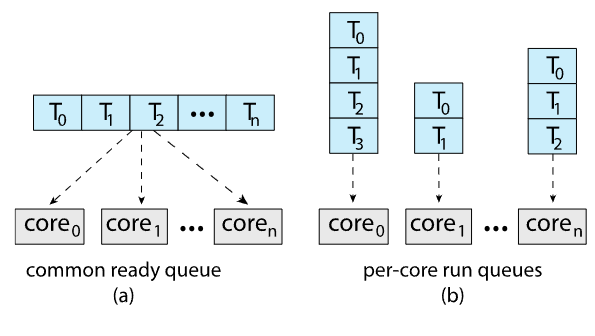COMP 3511: Lecture 12
Date: 2024-10-15 14:35:33
Reviewed:
Topic / Chapter:
summary
❓Questions
Notes
CPU Scheduling Algorithms (cont.)
gantt
A task :a1, 1, 30s
Another task :a2, after a1, 20s
Another task :a3, after a2, 20s
Another task :a4, after a3, 20s
axisFormat %S
-
SJF: can either be preemptive / non=preemptive
-
what if: new process arrives while another is executing?
- CPU: might switch to new process (if w/ shorter remaining time)
-
SRJF: SJF, but preemptive
-
example
process arrival burst 0 8 1 4 2 9 3 5 
- average waiting time:
-
SJF/SRTF and FCFS comparison
- possible: results in starving
- process w/ long burst time might keep delayed
- - possible: results in starving
-
Priority scheduling
- priority no.: associated w each process
- CPU: allocated to process w/ highest priority (= smallest integer)
- preemptive
- non-preemptive
- equal-priority process: scheduled in FCFS
- SJF: special case of priority scheduling algorithm
- priority: inverse of predicted next CPU burst
- problem: starvation: low priority process never executing
- solution: aging: as time progresses, priority process
- other solutions exist
- 👨🏫 or: periodically update the priority
- example
process burst priority 10 3 1 1 2 4 1 5 5 2 
- average waiting time: 8.2 msec
- when 2 ms quantum applied, w/ RR:
- 👨🏫 combination between priority and RR!

-
Multilevel queue
- multilevel queue scheduling: can be extension of priority scheduling
- e.g. priority assigned statically
- process: remains in the same queue for duration of runtime

- partition processes: depending on process type
- scheduling among queues: commonly implemented w/ fixed priority preemptive scheduling
- each queue w/ certain CPU time / time-slice
- scheduling among queues: commonly implemented w/ fixed priority preemptive scheduling
- multilevel queue scheduling: can be extension of priority scheduling
-
Multilevel feedback queue (MLFQ)
- process: move between various guess
- aging: implemented this way
- supports flexibility
- following parameters
- no. of queues
- scheduling algorithms for each queue
- method to determine when to upgrade / demote a process
- method to determining which queue to enqueue process
- example
- three queues
- : RR w/ ms
- : RR w/ ms
- : FCFS
- scheduling
- new job entering : served FCFS
- preempts jobs from if they are running
- if it doesn't finish in 8 ms: enqueue process to
- : served FCFS and receives 16 ms
- if it doesn't complete: enqueue process to
- if: a job from : preemptive by a new job of higher queue
- remains at the front of that queue (w/ remaining quantum)
- new job entering : served FCFS
- approximates SRTF
- CPU bound jobs: drop quickly
- short-running IO bound: stays near top
- 👨🏫 running on a CPU: means that queues above are empty
- upon preemption: interrupted process still stays front of the queue
- when prioritized process ends: (i.e. priority returns to second queue)
- then the interrupted process continues its remaining time quantum
- three queues
- process: move between various guess
-
Computation
- turnaround time: termination time - arrival time
- waiting time: turnaround time - CPU burst time
---
displayMode: compact
---
gantt
axisFormat %S
Requirements :a1, 1, 4s
Design :a2, after a1, 4s
Development :a3, after a2, 4s
Test :a4, after a3, 4s
-
MLFQ: Remarks
- MLFQ: commonly used in many systems (unix, Solaris, Windows, etc.)
- w/ distinctive advantages
- no need for prediction of CPU burst time
- handles interactive jobs well
- better than RR in terms of response time
- i.e. first quantum
- produces similar performance w/ SJF / SRTF
- short jobs: finish at Q0
- SJF / SRTF: theoretical & optimal
- MLFQ: practical & approximates
- fair: on performance for CPU-bound jobs
- no "complete" starvation
- possible starvation: handled by reshuffling jobs to different queues
- e.g. after some period: move all jobs to top queue
- 👨🎓 shake!
- 👨🏫 wonderful (& best) principle!
- no, or very little overhead!
- ❓ is there any criteria for quantum 1, 2, etc. in MLFQ?
- first quantum: 7-80%
- second: somewhat of a buffering - until it goes to FCFS
- design: must be considered carefully
- 2 level: may be better than 3-4
- CPU intensive environment, e.g. ML, has different consideration w/ DB query handler
Other Scheduling
-
Thread scheduling
- user thread: handled by programs
- no scheduler needed for on-to-one mapping
- yet: many-to-one or many-to-(smaller) many: requires scheduling on thread
- i.e. which task is mapped to thread currently?
- OS: uses intermediate data structure: lightweight process (LWP)
- between user threads & kernel threads
- programmer: assigns thread priority in program
-
Multiple-processor scheduling
- asymmetric: not to be discussed
- i.e. when one processor acts as a master
- symmetric multiprocessing (SMP)
- each processor: either self-scheduling or w/ one common ready queue
- e.g. one line for all counter (airport) / each counter (supermarket)
- both are common for SMP

- each processor: either self-scheduling or w/ one common ready queue
- asymmetric: not to be discussed